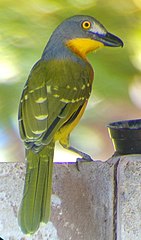
The bushshrikes are smallish passerine birds. They were formerly classed with the true shrikes in the family Laniidae, but are now considered sufficiently distinctive to be separated from that group as the family Malaconotidae, a name that alludes to their fluffy back and rump feathers.

The southern boubou is a bushshrike. Though these passerine birds and their relations were once included with true shrikes in the Laniidae, they are not closely related to that family.
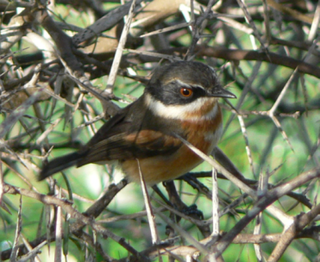
The Cape batis is a small, stout insect-eating passerine bird in the wattle-eye family. It is endemic to the Afromontane forests of southern Africa.

The bokmakierie is a bushshrike. This family of passerine birds is closely related to the true shrikes in the family Laniidae, and was once included in that group. This species is endemic to southern Africa, mainly in South Africa and Namibia, with an isolated population in the mountains of eastern Zimbabwe and western Mozambique.

The Cape robin-chat is a small passerine bird of the Old World flycatcher family Muscicapidae. It has a disjunct range from South Sudan to South Africa.

The neddicky, or piping cisticola, is a small passerine bird in the family Cisticolidae, which is native to Africa, southwards of the equator. Its strongholds are the light woodlands and shrublands of the subtropics and temperate regions of southern Africa. The common name, neddicky, is the Afrikaans name for the species.

The grey go-away-bird, also known as grey lourie, grey loerie, or kwêvoël, is a bold and common bird of the southern Afrotropics. They are present in arid to moist, open woodlands and thorn savanna, especially near surface water. They regularly form groups and parties that forage in tree tops, or dust bathe on the ground. Especially when disturbed, they make their presence known by their characteristically loud and nasal "kweh" or "go-way" calls, with the last syllable typically a descending drawl. Within their range, their unique combination of colour, appearance and habits precludes confusion with other bird species.

The brubru is a species of bushshrike found in most of Sub-Saharan Africa. It is the only member of the genus Nilaus.
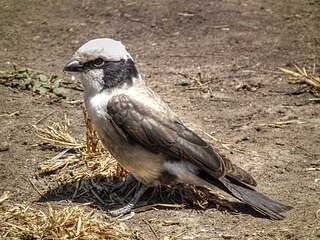
The northern white-crowned shrike or white-rumped shrike, is a shrike found in dry thornbush, semi-desert, and open acacia woodland in east Africa from south eastern South Sudan and southern Ethiopia to Tanzania. Its binomial name commemorates the German naturalist and explorer Eduard Rüppell.
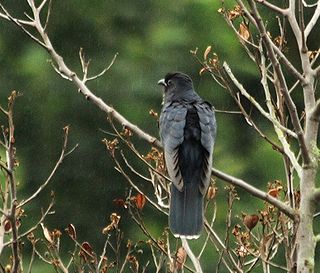
The black cuckoo is a species of cuckoo in the family Cuculidae. The species is distributed widely across sub-Saharan Africa. There are two subspecies. This cuckoo has a very wide range and is quite common so it is classified as a least-concern species by the International Union for Conservation of Nature.
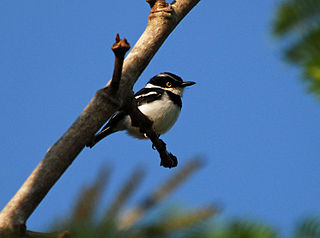
The eastern black-headed batis is a passerine bird in the family Platysteiridae from eastern Africa. It was formerly treated as conspecific with the western black-headed batis.
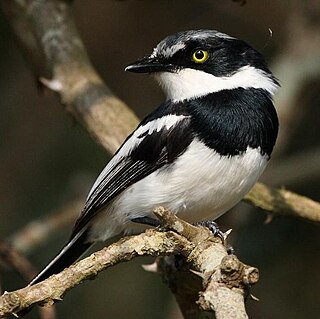
The chinspot batis is a small songbird of the genus Batis in the family Platysteiridae which is a common and widespread species in the woodlands of southern Africa from the Eastern Cape north to 3°N in southern Kenya and Gabon. It forms a superspecies with other rather similar members of the genus Batis.

The grey cuckooshrike is a species of bird in the cuckooshrike family Campephagidae. It is a medium-sized forest bird, with grey to blue-grey plumage and large black eyes. There are two subspecies that occur in forest patches of southern and central Africa respectively.

The black-backed puffback is a species of passerine bird in the family Malaconotidae. They are common to fairly common sedentary bushshrikes in various wooded habitats in Africa south of the equator. They restlessly move about singly, in pairs or family groups, and generally frequent tree canopies. Like others of its genus, the males puff out the loose rump and lower back feathers in display, to assume a remarkable ball-like appearance. They draw attention to themselves by their varied repertoire of whistling, clicking and rasping sounds. Their specific name cubla, originated with Francois Levaillant, who derived it from a native southern African name, where the "c" is an onomatopoeic click sound. None of the other five puffback species occur in southern Africa.

The swamp boubou, also known as the Gabon boubou, is a species of bird in the Malaconotidae or bushshrike family. It is native to western and southern Central Africa. In the north of their range, savannah thickets constitute an important part of their habitat, while in the south they are strongly associated with river systems and marshes, for which they are named. The pair bond appears to be maintained by duetting, which in the south is generally synchronous or overlapping. It is most similar to L. major major, with which it perhaps hybridizes, but the underpart plumage is immaculate white, while the female contributes a ratchet-like note to the duet.

Lagden's bushshrike is a bird species in the bushshrike family (Malaconotidae) native to Africa. It is a stocky bird with yellow or orange-yellow underparts, olive green upperparts, a grey head and heavy bill. Two subspecies are recognised, one found in west Africa and one in central Africa.

Monteiro's bushshrike is a species of bird in the bush-shrike family (Malaconotidae).

Swynnerton's robin is a species of bird in the family Muscicapidae. It is monotypic within the genus Swynnertonia. The common and Latin names commemorate the entomologist Charles Swynnerton.


